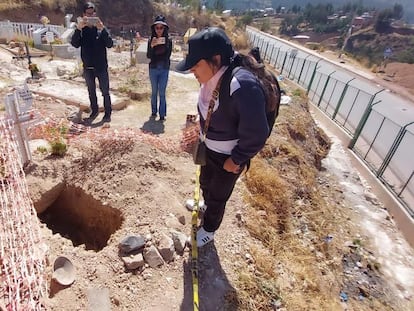A controversial airport in the Sacred Valley of the Incas
The project in Peruvian town of Chinchero could bring more tourists to this famous region but at the same time it would cause ‘irreversible’ social, environmental and cultural impacts, warn its detractors
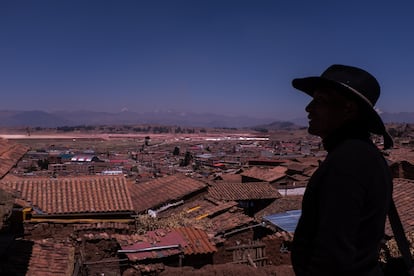
“The most tragic thing that has happened in Chinchero in recent years is the construction of the airport,” says Nilda Callañaupa, director of the Center for Traditional Textiles of Cusco in Peru, where dozens of women work and produce intricate designs with natural dyes. In this town in the south of the country, the Andean sky is dotted with clouds pierced by snowy peaks but, if you look down, the artisan’s fears are visible: among the fields and traditional tiled roof houses is a dusty airstrip under construction.
Since work began in 2018 on the new Chinchero International Airport (AICC), the peace of the Sacred Valley of the Incas has been broken. The region already hosts an aerodrome that moves over three million passengers per year: the Velasco Astete, in the city of Cusco, where those who want to visit the tourist jewel of Machu Picchu arrive. The AICC, located just 28 kilometers (17 miles) away, will be able to handle more than six million passengers, tripling the flow of visitors to the UNESCO World Heritage Site.
But there are other figures to consider. In 2017, UNESCO was on the verge of including the legendary Inca citadel on its list of endangered heritage. It did not do so precisely because Peru took measures to restrict the number of visitors. In 2020, the maximum number of visitors was set at 2,244 per day. However, in December 2022, the figure was raised to 4,044 and in June of this year it was announced that the possibility of raising it to more than 6,000 was being studied.
“Everything that gave Chinchero its value is being destroyed with this construction,” says historian Natalia Majluf, who in 2013 launched an online petition to try and stop the project. Since then, she has garnered 111,014 signatures, both from Peruvian citizens and professors from Harvard and Berkeley universities in the U.S. But those efforts proved futile. Work on the airport began at the end of 2018, causing a first wave of protests. In the second half of this year, the passenger terminal will be constructed and work on the runway will move forward. If all goes according to schedule, the airport will be ready in 2025.
This has prompted groups such as Salvemos Chinchero (Save Chinchero) and the Unión Ciudadana por la Defensa y Valoración del Patrimonio Cultural y del Ambiente (Citizen’s Union for the Defense and Valuation of Cultural Heritage and the Environment) to take action against what they consider irreversible damage to national heritage and the environment. They warn that under the 450 hectares of land the airport will occupy lie vital aquifers, as well as traces of Inca and colonial roads.
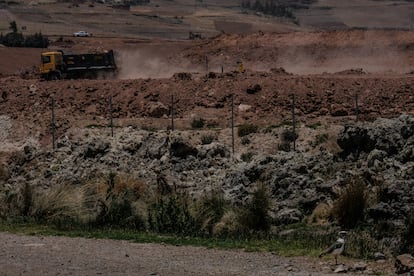
A construction project of this kind must have a Certificate of Non-existence of Archaeological Remains - something that, according to protestors, does not exist. The Ministry of Culture told this newspaper that the certificate has been issued, but at the time of publication it had not provided a copy. The airport does have the required environmental impact study, but this has been the subject of criticism. Researcher Carlos Soria published an article in which he points out that the report “does not specify what will happen to the water sources during and after construction, nor does it establish environmental management measures to reduce the impacts.”
In 2006, the National Institute of Culture issued a resolution declaring the Sacred Valley of the Incas as National Cultural Heritage. The norm establishes that “any new construction project” must have the approval of the central authority, which today is the Ministry of Culture. Tacitly, this ministry has given its approval to the AICC, by not objecting to its construction.
More than 16 million cubic meters of earth has already been removed at the site, which, according to detractors, may have damaged pre-Hispanic routes such as part of the Andean road system Qapaq Ñan, (Inca Trail, in Quechua), a UNESCO World Heritage Site since 2014. In other cases, the Ministry of Culture has been more severe. In 2018, for example, it demanded that the private Inkariy museum remove a statue of the god Wiracocha because it put the valley’s landscape at risk. More recently, the president of the Congress of the Republic of Peru, Alejandro Soto, who wanted to build a four-story house in the village of Yucay, was only authorized to raise two floors.
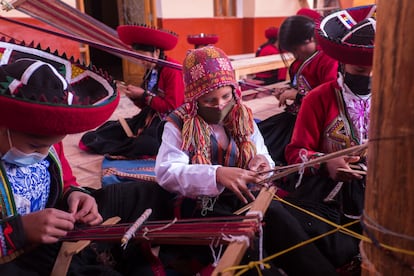
Drought risk
Marco Zeisser, an agronomist engineer living in Cusco, warns of the danger of “irreversible” changes in land use and rivers in the area “due to the compaction, asphalting and waterproofing of almost 500 hectares” within the airport’s perimeter. The Ministry of Transportation and Communications, on the other hand, claims that “the replenishment of the aquifer” is guaranteed. For Zeisser this is not the case and — as Soria points out in his work — he notes that the environmental impact study “does not correctly identify or characterize the basins involved, nor does it present the indispensable inventory of all the water sources.”
Water shortages are already being felt in Chinchero, with service only available for a few hours a day. The National Meteorology and Hydrology Service issued a report in 2016 detailing how the area is at high risk of drought. Due to the recurrence of the El Niño phenomenon, and the effects of climate change, the lack of water resources is becoming increasingly acute. The lequechu, an elusive bird that inhabits the wetlands above the airport and is traditionally believed to forecast rainfall, has recently become more difficult to spot in the vicinity of the AICC, according to local farmers.
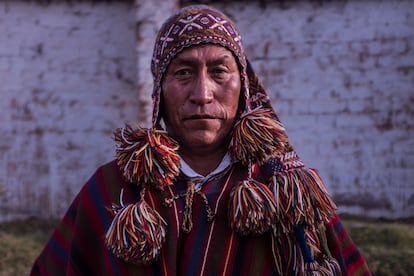
At a meeting of varayocs - indigenous authorities in place since pre-Hispanic times - in Chinchero there is concern about the opening of the airport. “When it enters the operational stage, it will be ugly,” says Eulogio Quispe, a man who holds the title of Pachaq Curaca, one of the most respected ranks among the varayocs. The other men and women share Quispe’s concern. They fear that the mass arrival of tourists — and the consequent construction of large hotel complexes — will mean the loss of some of the traditions such as the textile industry, or traditional ceremonies like the one held by the varayocs where the debate takes place.
But there are also residents who have accepted the construction of the airport. Verónika Tupayachi, an anthropologist from Cusco, points out: “There is a lot of racism in the country and some farmers sold their land for the airport in the hope that their children would do other things and not be discriminated against for being Quechua speakers or farmers.” As the years go by, she adds, the area may see fewer crops being planted and self-sufficiency may be at risk.
The project also has its supporters, who have organized demonstrations in favor. The opening of a second airport for international flights is a long-standing demand in Cusco, in order to avoid having to go through central Lima to visit Machu Picchu. But the AICC will not fulfill that function, according to a report by the State Agency for the Promotion of Private Investment, which states that 91% of flights will be domestic. That is assuming it functions at all. “The airport will be inoperable,” says Bruno Papi, a former Peruvian Air Force officer. It will be located at 3,700 meters above sea level and surrounded by high mountains, which makes landing and takeoff difficult and the handling of emergencies problematic. “First they build it and then they’ll have to try and figure out how to get in and out of it,” he says.
Sign up for our weekly newsletter to get more English-language news coverage from EL PAÍS USA Edition
Tu suscripción se está usando en otro dispositivo
¿Quieres añadir otro usuario a tu suscripción?
Si continúas leyendo en este dispositivo, no se podrá leer en el otro.
FlechaTu suscripción se está usando en otro dispositivo y solo puedes acceder a EL PAÍS desde un dispositivo a la vez.
Si quieres compartir tu cuenta, cambia tu suscripción a la modalidad Premium, así podrás añadir otro usuario. Cada uno accederá con su propia cuenta de email, lo que os permitirá personalizar vuestra experiencia en EL PAÍS.
¿Tienes una suscripción de empresa? Accede aquí para contratar más cuentas.
En el caso de no saber quién está usando tu cuenta, te recomendamos cambiar tu contraseña aquí.
Si decides continuar compartiendo tu cuenta, este mensaje se mostrará en tu dispositivo y en el de la otra persona que está usando tu cuenta de forma indefinida, afectando a tu experiencia de lectura. Puedes consultar aquí los términos y condiciones de la suscripción digital.
More information
Archived In
Últimas noticias
Welcome to the post-religion era: The idea of Christianity as the absolute truth has become obsolete
‘I thought you would like it’: The risky sexual practice popularized by TV shows and TikTok
The digitalization of tourism: ‘They promise experiences and gave us the worst possible one’
Mexican peso defies uncertainty with forecasts of a new period of stability in 2026
Most viewed
- Sinaloa Cartel war is taking its toll on Los Chapitos
- Reinhard Genzel, Nobel laureate in physics: ‘One-minute videos will never give you the truth’
- Oona Chaplin: ‘I told James Cameron that I was living in a treehouse and starting a permaculture project with a friend’
- Why the price of coffee has skyrocketed: from Brazilian plantations to specialty coffee houses
- Silver prices are going crazy: This is what’s fueling the rally

